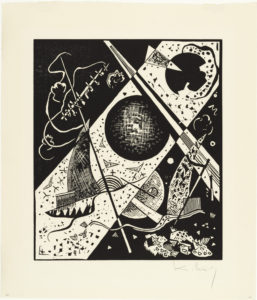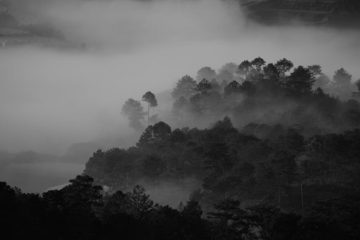\\ //
By Cleo Mikutta

– III –
// \\
On a cruise ship caught in a tropical storm, the chlorine water in the indoor swimming pool has begun to imitate the violent rhythm of the waves outside. The heavy armchairs in the lounge blow from side to side as though weightless.
At the edge of the troposphere, five kilometers above the surface of the Earth, the final engine of an aircraft flames out and fails to restart. We begin to fall three meters per second.
At her mother’s funeral, a girl is unable to cry.
In a circus caravan, a clown paints his face white.
In an anechoic chamber, a place so devoid of sound that it is measured in negative decibels, a man is unable to bear the silence any longer. Attempting to depart, he finds that his sense of orientation has dissolved.
On a small side street in a city, two strangers become friends.
At his grandparents‘ house, a boy molds the softened wax of a burning candle.
In a workshop, a potter carefully lays out the shards of a bowl on his table.
Wandering around a small flea market, a woman comes across an audiobook by Carl Sagan, titled Murmurs of Earth. She reads, “In the early autumn of 1977, two extraordinary spacecraft called Voyager were launched to the stars. Affixed to each was a gold-coated phonograph record inscribed with the music, images and sounds of our planet.”
She finds a NASA website monitoring Voyager One and Two’s progressive journey through interstellar space. She observes the ticking numbers for a while. The space probes are travelling approximately fifteen kilometers per second. Having departed forty-one years ago, they have since covered a distance of twenty-one billion kilometers.
She plays the discs. Track 3. “Greetings in 55 languages.” Track 4. “UN Greetings/Whale Greetings.” Track 5. “The Sounds of Earth.” Track 5.1. “Music of the Spheres.” Track 5.9. “Footsteps, Heartbeats, Laughter.” Track 5.16. “Kiss.” Track 6. “Brandenburg Concerto No. 2 in F. First Movement,” by J. S. Bach. Track 8. “Tchenhoukoumen,” percussion from Senegal, recorded by Charles Duvelle.
Track 13. “Flowing Streams,” a Chinese piece of music, played on the Guqin by Kuan P’ing-hu. The piece has an irregular rhythm. The moment the beat seems to settle, it shifts.
Taking in the fluctuating beat, she thinks of the space probes, carrying these fragmented outtakes of human life, and wonders if anyone else might be listening.
\\ //
Read Part 1 | Read Part 2 | Read Part 4 | Read Part 5
Image credit: Wassily Kandinsky, “Small Worlds VI” (Kleine Welten VI). Woodcut, 27.3 x 23.2 cm, from a portfolio of twelve prints, six lithographs (including two transferred from woodcuts), four drypoints, and two woodcuts. Berlin: Propyläen-Verlag, 1922. DIGITAL IMAGE © 2018, The Museum of Modern Art/Scala, Florence.



